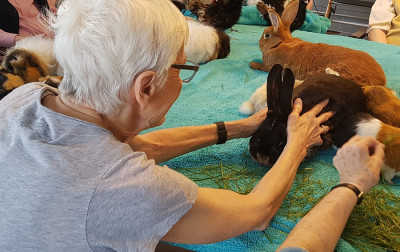Who saves who

"When the dogs go walking down the hall of the hospital, it's like the scene in The Wizard Oz when evrything changes from black and white... to COLOR" Judi Levicoff.
They are an important part of our lives and many of us know how good it is to have a pet while getting through tough experiences. No matter if the animals are trained or not; if we own and care for pets, it gives us a kind of therapy and health benefits. Pet therapy can help reduce stress, anxiety and depression. It can also improve social skills and increase self-esteem. Therapy animals help children with learning disabilities, anger management and behavioral difficulties; there are even dogs who help children how to read. More and more often animals are used in senior facilities because they can lower cholesterol levels, prevent heart attack and stroke or help to fight against depression. But that's not all! Those amazing creatures help also the family and friends of the person who needs the traetment - they say the presence of the animal makes them feel better too.
While talking about pet therapy, which is a very broad term, we have to define two phrases: Animal-Assisted Therapy (AAT) and Animal-Assisted Activities (AAA). AAT is including an animal in patient's treatment and AAA is using animals in recreational and visitation programs to help people with special needs. So does the therapy have any risks? Well, the biggest concerns is the safety and sanitation in hospitals. Most of the medical facilities have strict rules to ensure that the animals are clean, vaccinated, well-trained and with appropriate behaviour. Centers for Disease Control and Prevention has never received a report of any infection from a therapy animal.
The animal chosen for a particular therapy depends on the therapeutic goals of a person's treatement plan. Animals which are most often used in AAT are dogs, cats, horses, smallies, bird and reptiles.
DOGS
Cute and cuddly, dogs are the most popular animals used in pet therapy. They bring affection and comfort to people and are perfect for patients who live in confined living conditions. Most of the therapy dogs wear a special clothing to let people know that they are safe to interact with.
CATS
Even though cats are difficult to train and are not capable of performing a wide range of tasks which a dog can do, they are also used in therapies. Those animals are suitable for patients who are afraid of or intimidated by dogs. Those lovely individuals can be found in nursing homes where they roam around and cheer up the elderly.
HORSES
Also called equine therapy. Studies have shown that horse therapy is successful in improving following areas: assertiveness, emotional awareness, empathy, stress tolerance, flexibility, impulse control, problem-solving skills, self-actualization, independence, self-regard, social responsibility, interpersonal relationships. (source: http://www.crchealth.com/types-of-therapy/what-is-equine-therapy/)
REPTILES
Unbelievable? But true! Reptiles are now being used in London to offer comfort and emotional support to patients struggling with eating disorders and depression. If you want to take care of a raptile you need a great deal of concentration and attention. That helps the patients to cope with their mental, emotional or physical struggles. Caring for an unusual pet (which a reptile undeniably is) gives patients a dose of confidence.
SMALLIES
Smallies are small pets such as rabbits, hamsters or guinea pigs. They are trained to offer assistance, companionship and comfort to the patients. They help improving motor skills and offer several behavioral and emotional benefits.
BIRDS
Especially parrots are great birds to be an emotional support animals. the have a high level of empathy and can be taught phrases and words which might keep patients busy and occupied. Taking care or injured or abused birds can help veterans suffering from PTSD to ease the symptoms.
“There is something about the outside of a horse that is good for the inside of a man.” Winston Churchill said while talking about horseback riding. His words also refer to deeper meaning than just phasical exercise. Being around the animals; no matter if they are big or small, with soft fur or without fur at all; makes us humans feel better both in mind and in heart.
Photos, which you can see below, were taken in Klarastift in Münster, Germany during a meeting of its habitants with animals, which took place on 20th June 2017. There were two experts. The first one was Daan Vermeulen who is a dipl. physiotherapist with many years of experience in the geriatrics. In his animal-assisted therapy he works with a miniature pig Felix in geriatric and pedagogical area. Vermeulen is a well-known therapist with many publications in Germany, including the magazine "Tiergestützte". The second was a groupexperts from Eseltherapie Terhürne UG which offers animal therapy not only for seniors but also children, various seminars and courses.
During the meeting, the animals and their owners created a friendly and positive atmosphere, which allowed the habitants of Klarastift to relax, feel comfortable and simlpy smile.
Beata Jaranowska

















